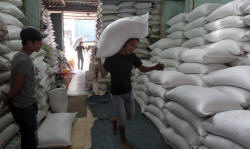|
The
Food and Agriculture Organization's (FAO) food price index,
which tracks international prices of the most globally traded
food commodities, averaged 133.2 points last month compared with
a revised 129.2 for September.
The September figure was previously given as 130.0.
The October reading was the highest for the index since July
2011. On a year-on-year basis, the index was up 31.3% in
October.
Agricultural commodity prices have risen steeply in the past
year, driven by harvest setbacks and strong demand.
The FAO's cereal price index rose by 3.2% in October from the
previous month. That was led by a 5% jump in wheat prices, which
climbed for a fifth consecutive month to reach their highest
since November 2012, FAO said.
"Tighter availability in global markets due to reduced harvests
in major exporters, especially Canada, the Russian Federation
and the United States of America, continued to put upward
pressure on prices," FAO said of wheat.
Wheat futures started November at new peaks, with U.S. prices at
fresh highs since 2012 and Paris front-month futures at a record
high as import demand remained brisk. [GRA/] [GRA/TEND]
World vegetable oil prices jumped 9.6% on the month to set a
record high, supported by further strength in palm oil prices as
labour shortages in Malaysia continued to hamper production, FAO
said. [POI/]
In contrast, global sugar prices eased 1.8% in October, ending a
run of six straight monthly rises, according to FAO.
Rome-based FAO cut its projection of global cereal production in
2021, to 2.793 billion tonnes from 2.800 billion estimated a
month ago, according to its cereal supply and demand outlook.
That mainly reflected reduced wheat output estimates for Iran,
Turkey and the United States, offsetting an increased forecast
for coarse grain production.
Expected world cereal output would still represent a record, but
would trail projected demand, leading to a fall in forecast
cereal stocks, FAO said.
Demand was supported by a raised projection of global cereal
trade to a new record, bolstered by increased wheat trade.
(Reporting by Gus Trompiz; Editing by Nick Macfie)
[© 2021 Thomson Reuters. All rights
reserved.] Copyright 2021 Reuters. All rights reserved. This material may not be published,
broadcast, rewritten or redistributed.
Thompson Reuters is solely responsible for this content.

|
|





